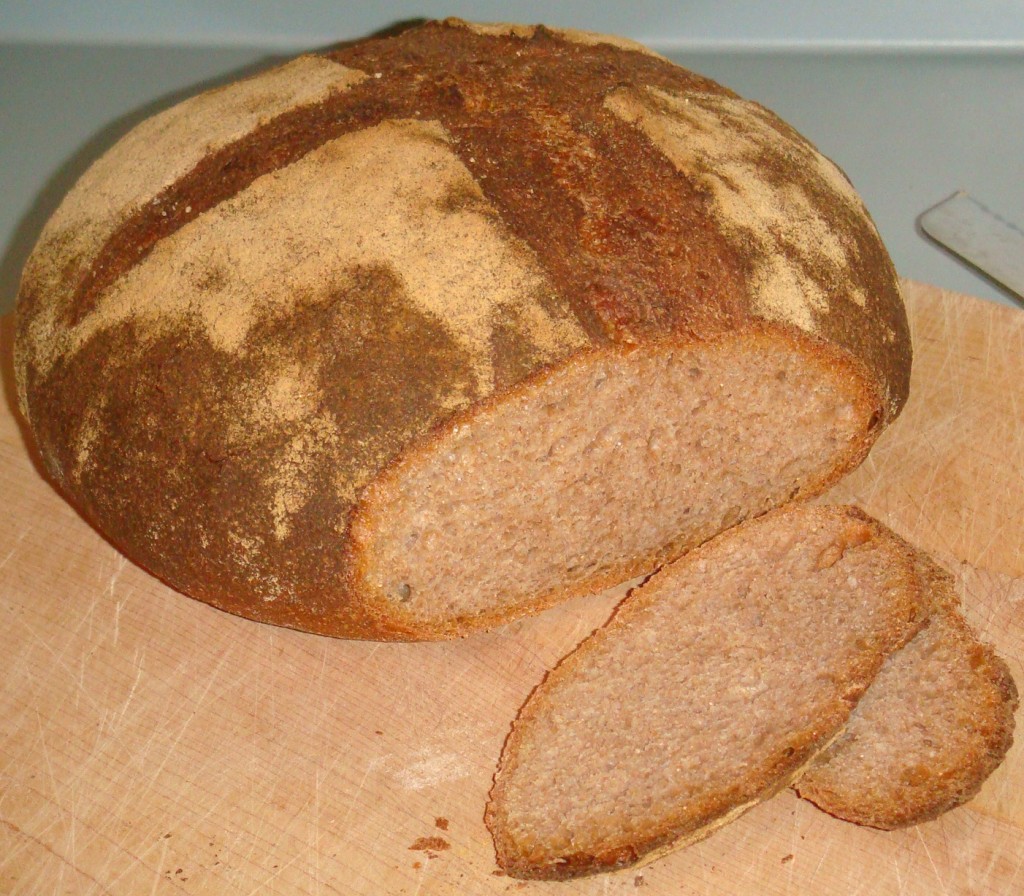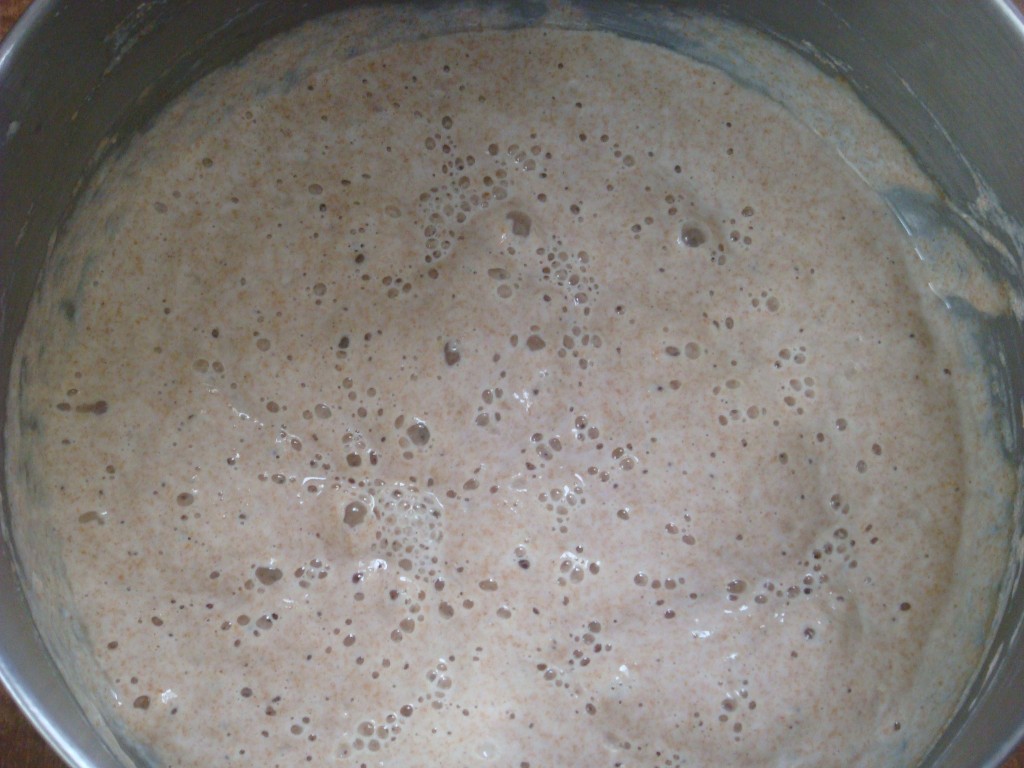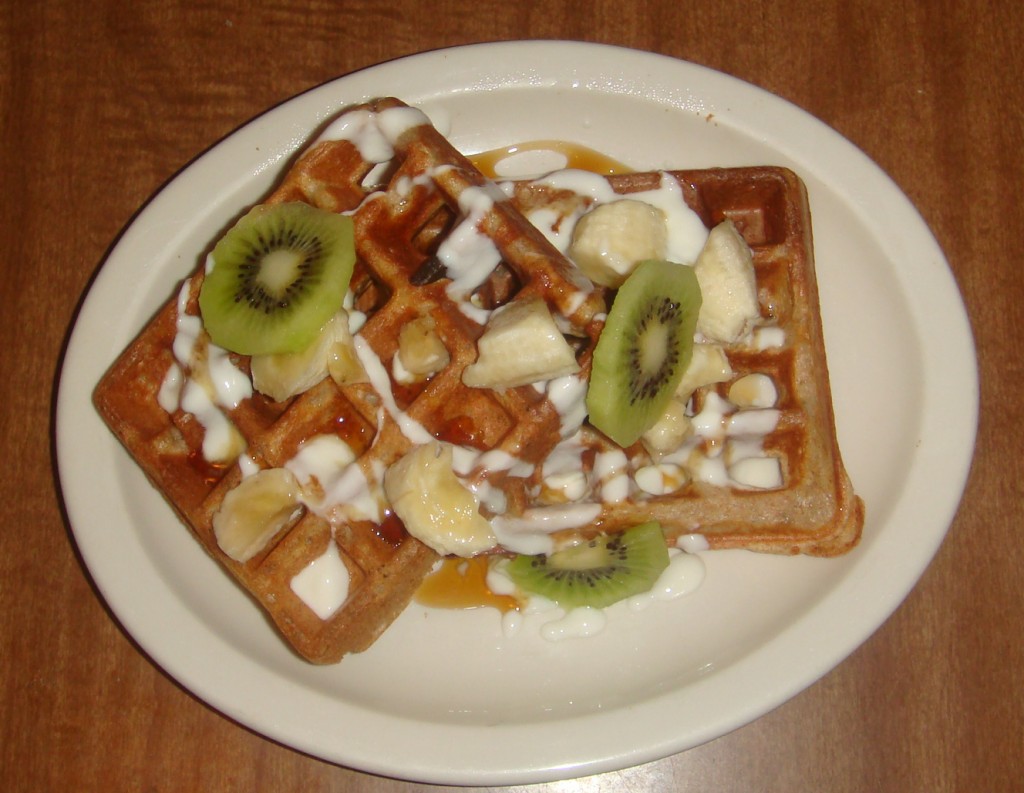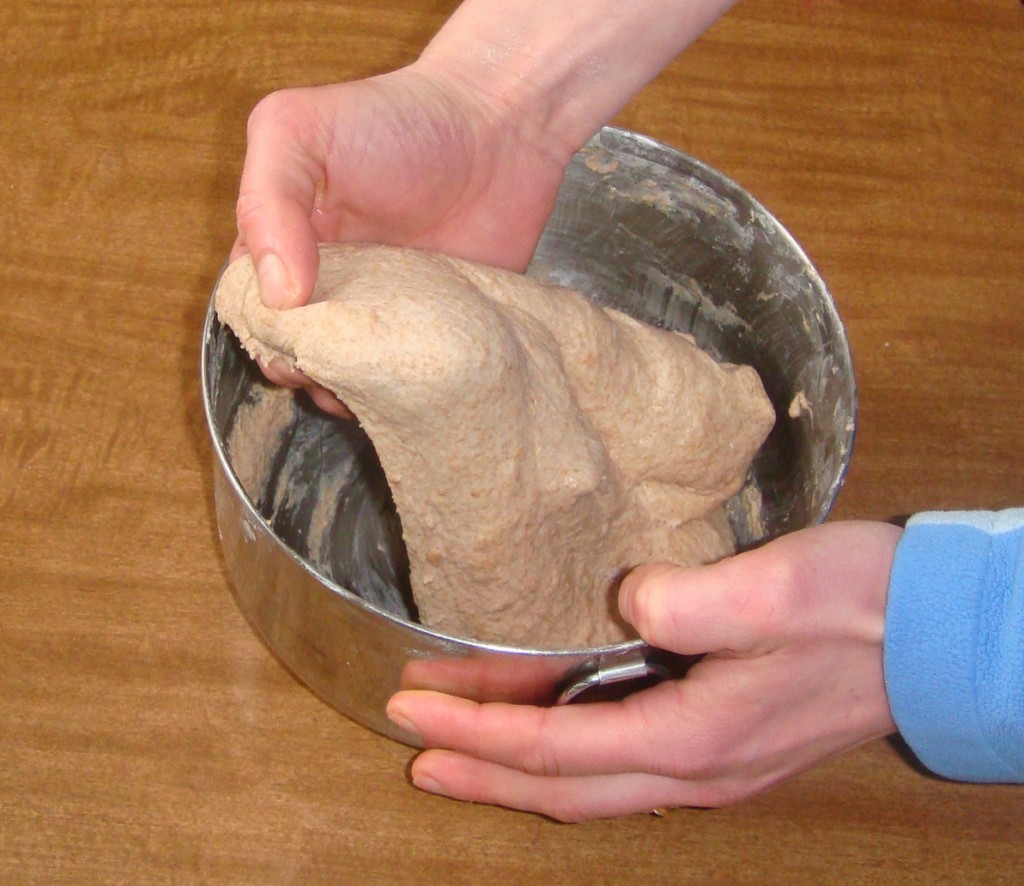Today, I welcome Amber Eisler to share a with us about the benefits and how-to’s of sourdough.
Sourdough is often thought of as a mysterious, temperamental, or outdated ingredient. However with a little information and experience anyone can bake using this traditional method of incorporating a live culture.
Sourdough is wild yeast and desirable bacteria living in a mixture of flour and water. It likely originated in ancient Egypt around 1500 BC. Sourdough will cause dough to leaven or rise, and can be used in place of commercial yeast. Sourdough is acidic, and contains various strains of lactobacilli that contribute to the development of flavor.
Baking with sourdough is a relatively slow process, as it does not leaven as fast as commercial yeast. During this slow rise the lactobacilli goes to work fermenting the dough. Through fermentation, the simple elements of flour, water, and salt are transformed into dough with wonderful, complex flavor. The slow fermentation also allows more time for the flour to hydrate, or soak up water. A higher hydration produces a moister, lighter crumb texture. The acidic nature of sourdough also improves the keeping quality of the bread.
Using a sourdough can improve the nutritional value when baking with whole grains. Whole wheat flour is more nutrient rich than white flour; however, bran (present in whole wheat flour) also contains phytic acid which binds minerals such as calcium, zinc, iron, and magnesium, making them difficult or impossible to assimilate by the body. Fermenting the flour with a sourdough culture neutralizes the effect of phytic acid, so the body is able to absorb the nutrients that the whole grain contains. Many people find sourdough breads more digestible whether or not they contain whole grains, a phenomenon usually attributed to the lactobacilli aiding the digestive process.
Keeping a sourdough culture lively and active is simple and easy once you establish a routine. There are many resources available to learn how to keep a sourdough culture, which requires a minimal amount of time and effort. For in-depth information on how to start and keep a sourdough culture check out informational videos on www.breadtopia.com, or refer to the sourdough primer on www.kingarthurflour.com (or check out the variety of sourdough starters available through Cultures for Health). Basically, the culture will need to be “fed” an equal portion (by weight) of flour and water. Stir it up and let it rest at room temperature until it is bubbly and fragrant. Use the amount needed for your recipe making sure to save some “seed” for your next batch. If the culture is left at room temperature it should be fed about twice a day. Otherwise, store it in refrigerator if you won’t be baking for a few days. If the culture is kept properly, the flavor in the final dough is mild, pleasant, and not bracingly acidic.
One of the easiest ways to get your feet wet using sourdough is to make sourdough waffles. Following is a simple, delicious, and nutritious recipe for whole wheat sourdough waffles:
Sourdough Waffles
2 cups Whole Wheat Flour
1 cup Sourdough culture (bubbly and active)
2 cups Milk or Buttermilk
1 tablespoon Maple Syrup
2 Eggs
¼ cup Butter, melted
½ teaspoon Salt
1 teaspoon Baking Soda
Combine the flour, sourdough, and milk. Allow to rest at room temperature for 8-12 hours. Whisk together the eggs and butter. Add all remaining ingredients to the flour mixture. Whisk until just combined.
Cook in a waffle iron. Serve with maple syrup, yogurt, and fresh fruit.
Whole Wheat Sourdough Bread
Here is a recipe for basic 100% Whole Wheat Sourdough bread (pictured at the top of this post). This recipe yields one large, hearty, versatile loaf. We use it for toast, sandwiches, or just slathered with butter:
1 cup Sourdough, bubbly & active (about 8 hours after feeding)
1 ¼ – 1 ½ cups water
3 ½ cups Whole Wheat Flour
1 ½ teaspoons Salt
Mix all of the ingredients with a wooden spoon, dough whisk, or by hand until the dough comes together. Add water as necessary to achieve a wet dough. Turn out of the bowl and knead by hand for about 5 minutes, or until the dough becomes elastic. It should be somewhat wet and tacky. Resist the urge to add more flour!
Place the dough back in the bowl and cover loosely with a towel. Let it rest for 3-4 hours, gently deflating and folding the dough every hour. If your kitchen is cool (as mine always is in Vermont!) you may extend this resting period up to 6 hours.
Shape the dough into a tight round ball and place seam side up in a bowl lined with a floured linen or cotton tea towel. Alternately you can shape it into a rectangle and place it in a greased loaf pan.
Let it rise in a warm place for about an hour. Or place in the refrigerator for a very slow (overnight) final rise.
Pre-heat the oven with a pizza stone on the middle rack to 450. When the oven is hot, place a square of parchment paper on a bakers peel or an inverted cookie sheet. Turn the dough out onto the paper so the seam is now down. Slash the top of the loaf with a serrated knife (to allow steam to escape and for further expansion in the oven). Slide the dough onto the pizza stone. Bake for 20 minutes at 450 then turn the oven down to 400 and bake an additional 30 minutes. If baking in a loaf pan the pizza stone is optional.
A few tips when making whole- grain sourdough bread:
The wetter the better! Remember that the flour will continue to absorb water during the fermentation (rising) process. When the initial mix is complete, the dough should be slack. Excess flour will yield a dry, crumbly, dense loaf.
Add steam. Steam in the oven allows the bread to get maximum volume and good texture. Place a small pan with a half cup of hot water in the bottom of the oven just after you load the bread in.
Practice often and have fun!
Amber Eisler is a Christian wife, mother, and part-time bread baker. She lives in Vermont with her husband Doug and daughter Abigail (2).
Helpful Cookbooks:
Baking with Sourdough – a wonderful collection of 21 recipes
Classic Sourdoughs: A Home Baker’s Handbook
Wild Bread – Handbaked sourdough artisan breads in your own kitchen – one of the best sourdough cookbooks available
Further Resources:
Laura’s Guide to Building Your Own Sourdough Starter – a step by step tutorial on sourdough starters along with recipes




OK, I have a question regarding keeping this alive in the fridge. I read to feed it once a week, but do I just stir in some flour and water and leave it in the fridge, or do I need to bring the whole thing back to room temp and then put it back? How exactly does it work to keep it alive in the fridge?
No, you can keep it in the fridge. Just stir in the flour and water and return to the fridge.
Could of been too wet, but more likely what bakers call underdeveloped. If it is very slack after the initial mixing, continue the gluten development by folding the dough every 20 minutes or so. Also, it could have been overproofed – too much time on the final rise. Keep at it!
My loaf is flat…when I turned out onto the parchment, it lost some of its rise. I’m thinking I let the loaf stay too wet. It was very sticky. Any other ideas?
Is the starter dead if it’s not bubbly? My mom gave me some starter, but it isn’t bubbly- I’ve been using it anyways, is that bad? I’m glad to see by the comments that I’m not the only one who was/is scared of sourdough or totally confused by the steps!
I just happened to have my starter activated when I saw this recipe, so I made the waffles. Very good! Such a light texture! My kids have been asking me to make them again. Thanks!
Thanks for the lesson on sour dough bread. I just made home made white bread and hot rolls already this week, so maybe next I’ll try sour dough!
Ha!! I just started my starter a week ago and was looking on line for some recipes. Thanks!!
Thanks for putting up this guest post, Lindsay. Thanks also to Amber for taking the time to explain the process. I’ve been thinking of trying sour dough bread and you’ve given me some more inspiration! God bless!
Thanks so much for all this info! I will definitely use this.
Great post! Thanks for sharing! I have been wanting to make sourdough bread for the last few months (it’s one of my favorite breads!!) but have not had time to do it. Maybe this will motivate me to give it a try!
Thank you for sharing these recipes! Due to health issues, sourdough is one of the only types of breads I can actually eat. I have never made my own sourdough because I have been afraid it wouldn’t turn out, but I’m going to give it a try this week! Thanks for tips!
I’ve been using the recipe from breadtopia.com for no knead sourdough bread. It’s the easiest, cheapest, and tastiest bread I’ve ever made! My husband is always asking me to make him more “dutch oven bread” at least once a week. The tutorial on the website was super helpful; check it out!
For those interested in sourdough recipes, you should check out Sarah’s Musings Blog. Yum!
Great thanks for sharing I cant wait to try! I LOVE LOVE LOVE your site!
This is perfect! My starter will be ready in the morning. I was looking for a good recipe and this look amazing!
I’ve been afraid of sourdough since I last had a starter. It was great until it turned black!!
I am making sourdough bread right now. It’s been rising for a couple of hours. It’s an experimental recipe with an experimental starter. What can I say, I’m in the experimental phase right now! I enjoyed this post. I’ve been trying to read up all different versions of starting a sourdough starter and making a wholesome 100% whole wheat sourdough bread. I will have to try this out. This version is very different from some of the others I’ve seen. The starter reminds me of the starter recipe in Nourishing Tradition by Sally Fallon. Are you familiar with this book, is the starter that liquidy?
I enjoyed this post. I’ve been trying to read up all different versions of starting a sourdough starter and making a wholesome 100% whole wheat sourdough bread. I will have to try this out. This version is very different from some of the others I’ve seen. The starter reminds me of the starter recipe in Nourishing Tradition by Sally Fallon. Are you familiar with this book, is the starter that liquidy?
Yes, this starter is liquidy (pancake batter consistency). A more liquidy starter develops more lactic acid, a firmer starter develops more acetic acid.
Nourishing Traditions is great – I just can’t get into organ meats:)
I’m linking to this great tutorial!
So… what does this whole “by weight” thing mean? How do you measure your flour, etc. by weight?
Thanks for the post! I received a starter recently from a husband’s colleague, but I let it go to long forgetting to feed it… now I need to start over.
The most accurate way to measure flour is actually by weighing it. A small kitchen scale is very useful for bread baking as many recipes use units of weight rather than volume. If you do not have a scale, a cup of flour weighs about 4-4 1/2 oz.(depending on if you measure a more or less “packed” cup). So, you could feed a sourdough 1 cup of water to 2 cups of flour. I work in a bakery part-time and we measure everything by weight. At home, sometimes I weigh and sometimes I use the good old measuring cups.
I can’t wait to try this – YUM!
I’ve got a starter going and have been wanting a sourdough waffle recipe. Can’t wait to try it, yum.
@Tonia, my friend who’s gluten-free has been doing gf sourdough with a starter she made herself.
It was actually on my list to figure out hoe to make a whole wheat sourdough. Great timing- thanks!
I used to love sourdough before I was diagnosed with Celiac Disease in 2006. Now I can’t have anything with wheat, barley, or rye. I am wondering – can you make sourdough with gluten-free grains?
It all looks delicious! Does anyone have suggestions for those with a gluten allergy? I’d love to still make sourdough, but lack a good recipe.
This is a very timely post for me as I am on day three of making my first starter. Quick question: I started my starter with rye flour because I wanted to use it up. As I feed my starter can I feed it with different flours? Can I make my bread with a different flour than my starter?
Yes, you can change a rye starter into a wheat one. Often sourdough starters are initiated with rye flour because of it’s high enzematic activity, then eventually only fed wheat flour. I wouldn’t mix up the flours too often to ensure the vitality of the culture.
You can make breads with a different flour than is in the stater. I make a flax seed bread that has a rye sourdough and wheat in the final dough. I have also made a bread that has both a wheat and a rye sourdough. It produced a very flavorful loaf.
Thanks so much. I think I will finish making my starter with rye flour and start adding whole wheat over time and keep it whole wheat. It is really active and smelly already.
It is so funny to see this post! I just started a new sourdough starter yesterday. My kids are so excited to have homemade sourdough bread again!
Well . . .my new sourdough starter is finally bubbly (although I’m not sure I trust it for bread yet). Those waffles look so good! I may have to whip up something similar for lunch–I’m a breakfast anytime kind of girl.
And thanks for the tip about staying ‘soggy’ for the whole grain bread. I often find mine is too dry if I don’t watch out.